Understanding Teenage Depression: Causes and Prevention Methods
VerifiedAdded on 2023/03/30
|7
|1901
|214
Essay
AI Summary
This essay examines the common causes of depression among teenagers, including traumatic events, stressful home environments, bullying, academic pressure, hormonal imbalances, inherited traits, and substance abuse. It also discusses various strategies for preventing or minimizing depression, such as early identification, medical treatment, talk therapy, social support, and healthy lifestyle choices. The essay emphasizes that depression is a treatable condition that requires a combination of approaches to address the complex interplay of genetic, biological, psychological, and environmental factors. Desklib provides access to a variety of student-contributed assignments and study tools.
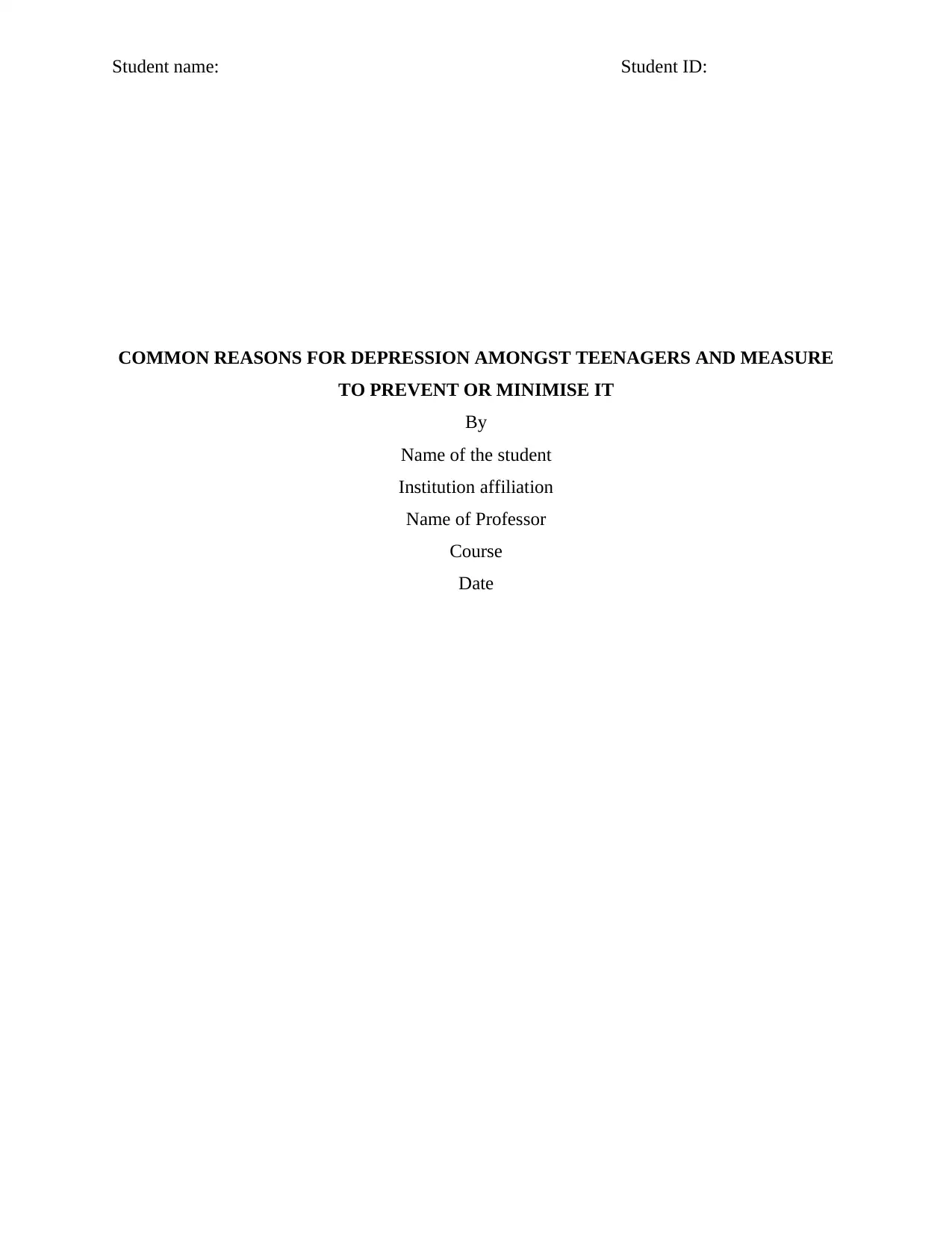
Student name: Student ID:
COMMON REASONS FOR DEPRESSION AMONGST TEENAGERS AND MEASURE
TO PREVENT OR MINIMISE IT
By
Name of the student
Institution affiliation
Name of Professor
Course
Date
COMMON REASONS FOR DEPRESSION AMONGST TEENAGERS AND MEASURE
TO PREVENT OR MINIMISE IT
By
Name of the student
Institution affiliation
Name of Professor
Course
Date
Paraphrase This Document
Need a fresh take? Get an instant paraphrase of this document with our AI Paraphraser
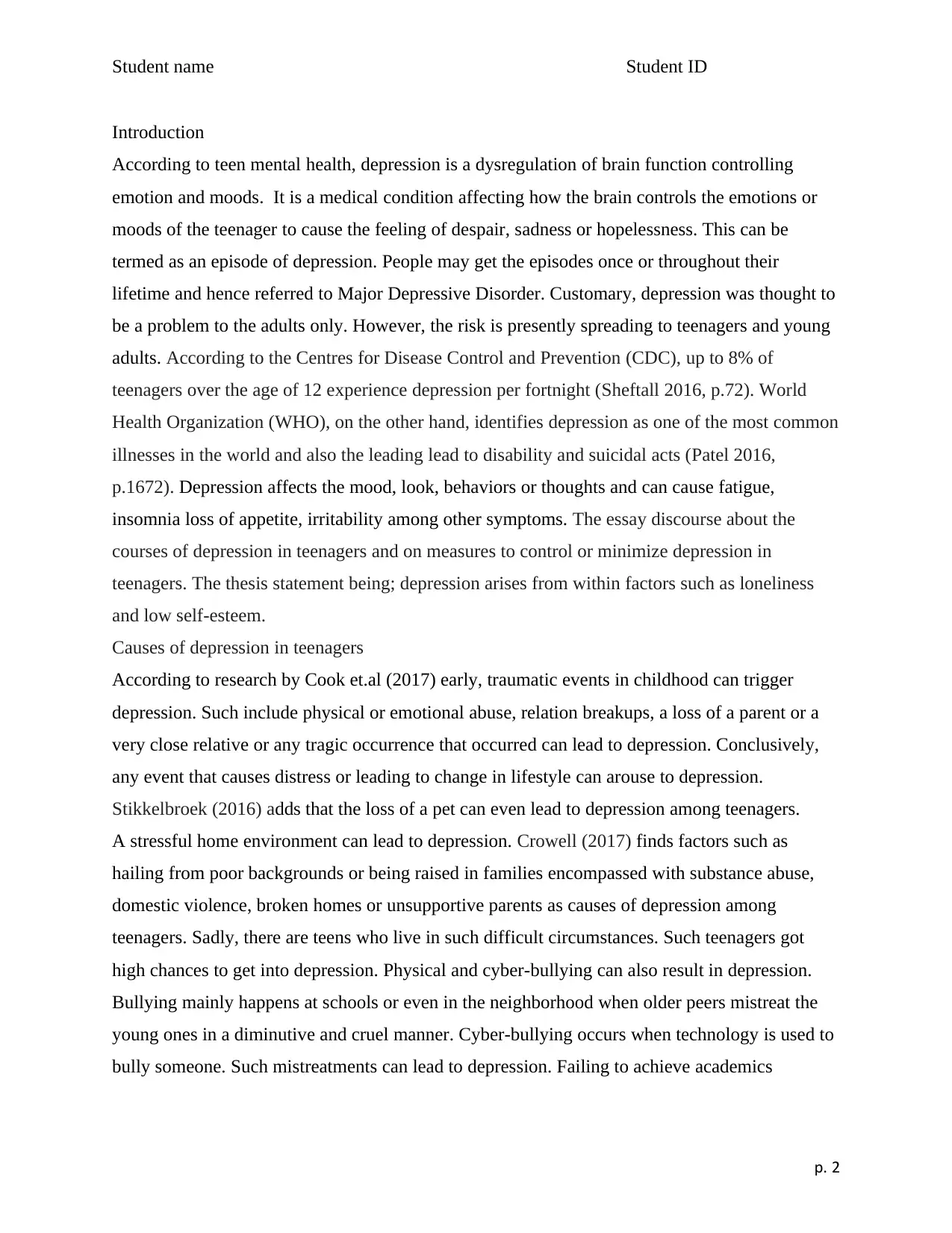
Student name Student ID
Introduction
According to teen mental health, depression is a dysregulation of brain function controlling
emotion and moods. It is a medical condition affecting how the brain controls the emotions or
moods of the teenager to cause the feeling of despair, sadness or hopelessness. This can be
termed as an episode of depression. People may get the episodes once or throughout their
lifetime and hence referred to Major Depressive Disorder. Customary, depression was thought to
be a problem to the adults only. However, the risk is presently spreading to teenagers and young
adults. According to the Centres for Disease Control and Prevention (CDC), up to 8% of
teenagers over the age of 12 experience depression per fortnight (Sheftall 2016, p.72). World
Health Organization (WHO), on the other hand, identifies depression as one of the most common
illnesses in the world and also the leading lead to disability and suicidal acts (Patel 2016,
p.1672). Depression affects the mood, look, behaviors or thoughts and can cause fatigue,
insomnia loss of appetite, irritability among other symptoms. The essay discourse about the
courses of depression in teenagers and on measures to control or minimize depression in
teenagers. The thesis statement being; depression arises from within factors such as loneliness
and low self-esteem.
Causes of depression in teenagers
According to research by Cook et.al (2017) early, traumatic events in childhood can trigger
depression. Such include physical or emotional abuse, relation breakups, a loss of a parent or a
very close relative or any tragic occurrence that occurred can lead to depression. Conclusively,
any event that causes distress or leading to change in lifestyle can arouse to depression.
Stikkelbroek (2016) adds that the loss of a pet can even lead to depression among teenagers.
A stressful home environment can lead to depression. Crowell (2017) finds factors such as
hailing from poor backgrounds or being raised in families encompassed with substance abuse,
domestic violence, broken homes or unsupportive parents as causes of depression among
teenagers. Sadly, there are teens who live in such difficult circumstances. Such teenagers got
high chances to get into depression. Physical and cyber-bullying can also result in depression.
Bullying mainly happens at schools or even in the neighborhood when older peers mistreat the
young ones in a diminutive and cruel manner. Cyber-bullying occurs when technology is used to
bully someone. Such mistreatments can lead to depression. Failing to achieve academics
p. 2
Introduction
According to teen mental health, depression is a dysregulation of brain function controlling
emotion and moods. It is a medical condition affecting how the brain controls the emotions or
moods of the teenager to cause the feeling of despair, sadness or hopelessness. This can be
termed as an episode of depression. People may get the episodes once or throughout their
lifetime and hence referred to Major Depressive Disorder. Customary, depression was thought to
be a problem to the adults only. However, the risk is presently spreading to teenagers and young
adults. According to the Centres for Disease Control and Prevention (CDC), up to 8% of
teenagers over the age of 12 experience depression per fortnight (Sheftall 2016, p.72). World
Health Organization (WHO), on the other hand, identifies depression as one of the most common
illnesses in the world and also the leading lead to disability and suicidal acts (Patel 2016,
p.1672). Depression affects the mood, look, behaviors or thoughts and can cause fatigue,
insomnia loss of appetite, irritability among other symptoms. The essay discourse about the
courses of depression in teenagers and on measures to control or minimize depression in
teenagers. The thesis statement being; depression arises from within factors such as loneliness
and low self-esteem.
Causes of depression in teenagers
According to research by Cook et.al (2017) early, traumatic events in childhood can trigger
depression. Such include physical or emotional abuse, relation breakups, a loss of a parent or a
very close relative or any tragic occurrence that occurred can lead to depression. Conclusively,
any event that causes distress or leading to change in lifestyle can arouse to depression.
Stikkelbroek (2016) adds that the loss of a pet can even lead to depression among teenagers.
A stressful home environment can lead to depression. Crowell (2017) finds factors such as
hailing from poor backgrounds or being raised in families encompassed with substance abuse,
domestic violence, broken homes or unsupportive parents as causes of depression among
teenagers. Sadly, there are teens who live in such difficult circumstances. Such teenagers got
high chances to get into depression. Physical and cyber-bullying can also result in depression.
Bullying mainly happens at schools or even in the neighborhood when older peers mistreat the
young ones in a diminutive and cruel manner. Cyber-bullying occurs when technology is used to
bully someone. Such mistreatments can lead to depression. Failing to achieve academics
p. 2
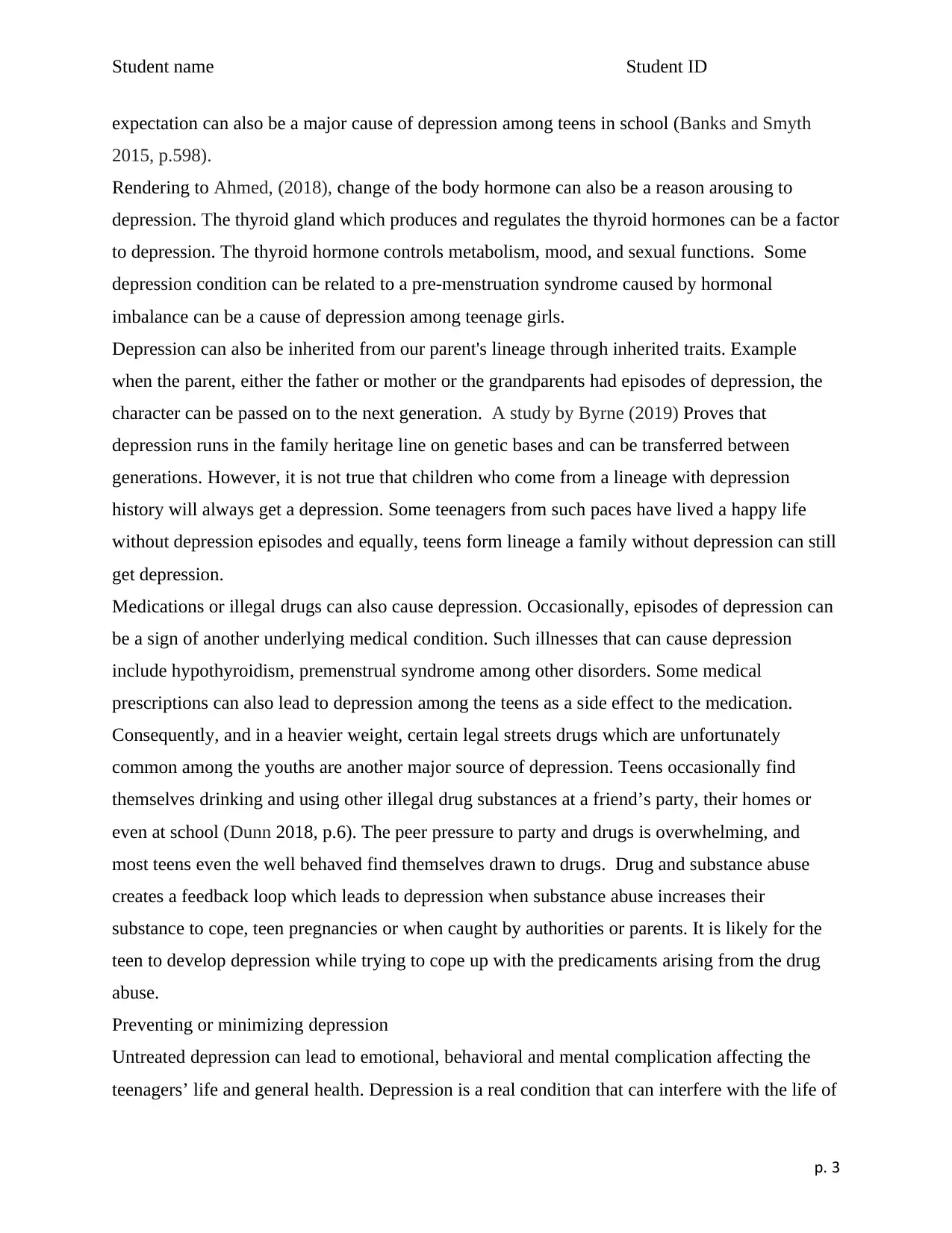
Student name Student ID
expectation can also be a major cause of depression among teens in school (Banks and Smyth
2015, p.598).
Rendering to Ahmed, (2018), change of the body hormone can also be a reason arousing to
depression. The thyroid gland which produces and regulates the thyroid hormones can be a factor
to depression. The thyroid hormone controls metabolism, mood, and sexual functions. Some
depression condition can be related to a pre-menstruation syndrome caused by hormonal
imbalance can be a cause of depression among teenage girls.
Depression can also be inherited from our parent's lineage through inherited traits. Example
when the parent, either the father or mother or the grandparents had episodes of depression, the
character can be passed on to the next generation. A study by Byrne (2019) Proves that
depression runs in the family heritage line on genetic bases and can be transferred between
generations. However, it is not true that children who come from a lineage with depression
history will always get a depression. Some teenagers from such paces have lived a happy life
without depression episodes and equally, teens form lineage a family without depression can still
get depression.
Medications or illegal drugs can also cause depression. Occasionally, episodes of depression can
be a sign of another underlying medical condition. Such illnesses that can cause depression
include hypothyroidism, premenstrual syndrome among other disorders. Some medical
prescriptions can also lead to depression among the teens as a side effect to the medication.
Consequently, and in a heavier weight, certain legal streets drugs which are unfortunately
common among the youths are another major source of depression. Teens occasionally find
themselves drinking and using other illegal drug substances at a friend’s party, their homes or
even at school (Dunn 2018, p.6). The peer pressure to party and drugs is overwhelming, and
most teens even the well behaved find themselves drawn to drugs. Drug and substance abuse
creates a feedback loop which leads to depression when substance abuse increases their
substance to cope, teen pregnancies or when caught by authorities or parents. It is likely for the
teen to develop depression while trying to cope up with the predicaments arising from the drug
abuse.
Preventing or minimizing depression
Untreated depression can lead to emotional, behavioral and mental complication affecting the
teenagers’ life and general health. Depression is a real condition that can interfere with the life of
p. 3
expectation can also be a major cause of depression among teens in school (Banks and Smyth
2015, p.598).
Rendering to Ahmed, (2018), change of the body hormone can also be a reason arousing to
depression. The thyroid gland which produces and regulates the thyroid hormones can be a factor
to depression. The thyroid hormone controls metabolism, mood, and sexual functions. Some
depression condition can be related to a pre-menstruation syndrome caused by hormonal
imbalance can be a cause of depression among teenage girls.
Depression can also be inherited from our parent's lineage through inherited traits. Example
when the parent, either the father or mother or the grandparents had episodes of depression, the
character can be passed on to the next generation. A study by Byrne (2019) Proves that
depression runs in the family heritage line on genetic bases and can be transferred between
generations. However, it is not true that children who come from a lineage with depression
history will always get a depression. Some teenagers from such paces have lived a happy life
without depression episodes and equally, teens form lineage a family without depression can still
get depression.
Medications or illegal drugs can also cause depression. Occasionally, episodes of depression can
be a sign of another underlying medical condition. Such illnesses that can cause depression
include hypothyroidism, premenstrual syndrome among other disorders. Some medical
prescriptions can also lead to depression among the teens as a side effect to the medication.
Consequently, and in a heavier weight, certain legal streets drugs which are unfortunately
common among the youths are another major source of depression. Teens occasionally find
themselves drinking and using other illegal drug substances at a friend’s party, their homes or
even at school (Dunn 2018, p.6). The peer pressure to party and drugs is overwhelming, and
most teens even the well behaved find themselves drawn to drugs. Drug and substance abuse
creates a feedback loop which leads to depression when substance abuse increases their
substance to cope, teen pregnancies or when caught by authorities or parents. It is likely for the
teen to develop depression while trying to cope up with the predicaments arising from the drug
abuse.
Preventing or minimizing depression
Untreated depression can lead to emotional, behavioral and mental complication affecting the
teenagers’ life and general health. Depression is a real condition that can interfere with the life of
p. 3
⊘ This is a preview!⊘
Do you want full access?
Subscribe today to unlock all pages.

Trusted by 1+ million students worldwide
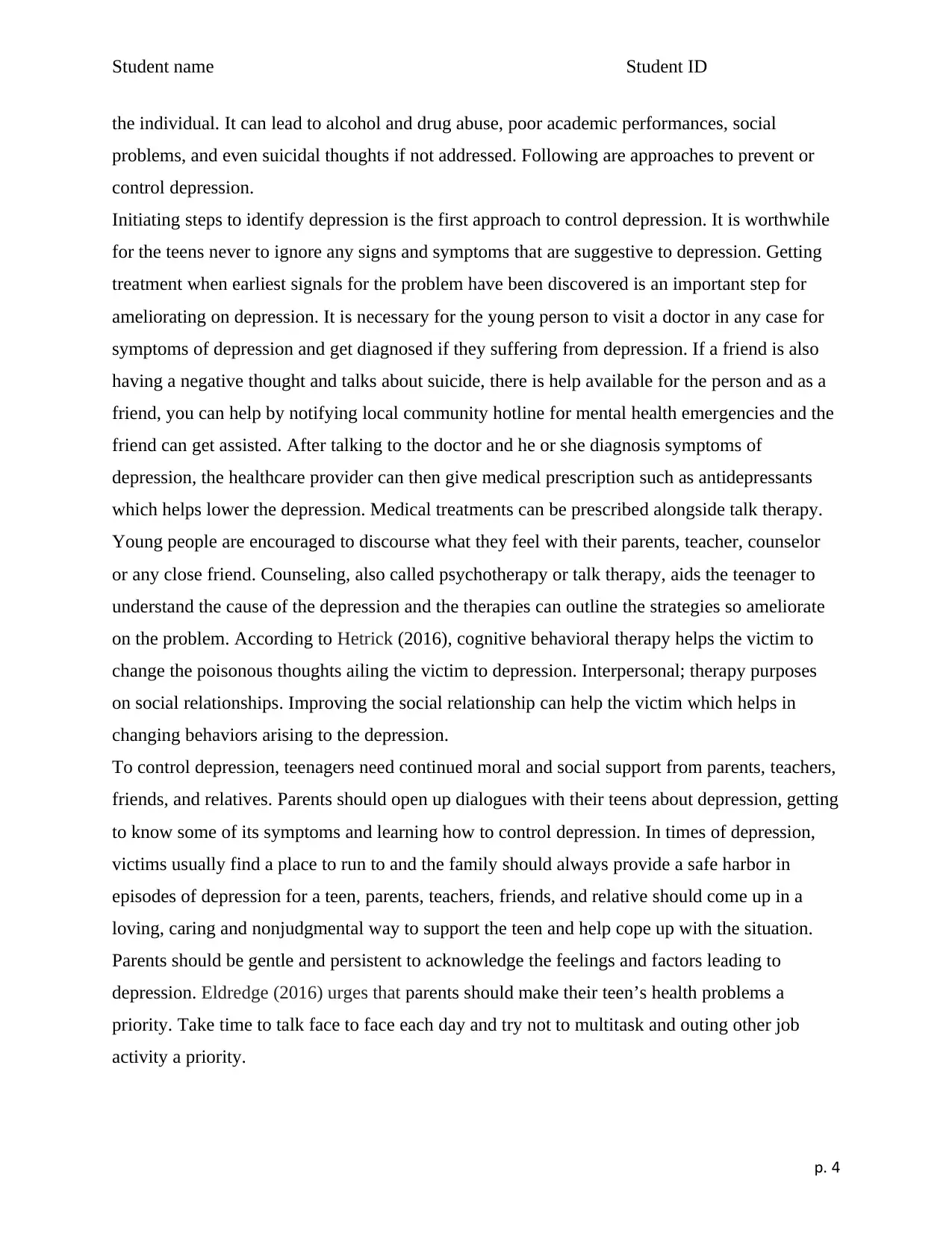
Student name Student ID
the individual. It can lead to alcohol and drug abuse, poor academic performances, social
problems, and even suicidal thoughts if not addressed. Following are approaches to prevent or
control depression.
Initiating steps to identify depression is the first approach to control depression. It is worthwhile
for the teens never to ignore any signs and symptoms that are suggestive to depression. Getting
treatment when earliest signals for the problem have been discovered is an important step for
ameliorating on depression. It is necessary for the young person to visit a doctor in any case for
symptoms of depression and get diagnosed if they suffering from depression. If a friend is also
having a negative thought and talks about suicide, there is help available for the person and as a
friend, you can help by notifying local community hotline for mental health emergencies and the
friend can get assisted. After talking to the doctor and he or she diagnosis symptoms of
depression, the healthcare provider can then give medical prescription such as antidepressants
which helps lower the depression. Medical treatments can be prescribed alongside talk therapy.
Young people are encouraged to discourse what they feel with their parents, teacher, counselor
or any close friend. Counseling, also called psychotherapy or talk therapy, aids the teenager to
understand the cause of the depression and the therapies can outline the strategies so ameliorate
on the problem. According to Hetrick (2016), cognitive behavioral therapy helps the victim to
change the poisonous thoughts ailing the victim to depression. Interpersonal; therapy purposes
on social relationships. Improving the social relationship can help the victim which helps in
changing behaviors arising to the depression.
To control depression, teenagers need continued moral and social support from parents, teachers,
friends, and relatives. Parents should open up dialogues with their teens about depression, getting
to know some of its symptoms and learning how to control depression. In times of depression,
victims usually find a place to run to and the family should always provide a safe harbor in
episodes of depression for a teen, parents, teachers, friends, and relative should come up in a
loving, caring and nonjudgmental way to support the teen and help cope up with the situation.
Parents should be gentle and persistent to acknowledge the feelings and factors leading to
depression. Eldredge (2016) urges that parents should make their teen’s health problems a
priority. Take time to talk face to face each day and try not to multitask and outing other job
activity a priority.
p. 4
the individual. It can lead to alcohol and drug abuse, poor academic performances, social
problems, and even suicidal thoughts if not addressed. Following are approaches to prevent or
control depression.
Initiating steps to identify depression is the first approach to control depression. It is worthwhile
for the teens never to ignore any signs and symptoms that are suggestive to depression. Getting
treatment when earliest signals for the problem have been discovered is an important step for
ameliorating on depression. It is necessary for the young person to visit a doctor in any case for
symptoms of depression and get diagnosed if they suffering from depression. If a friend is also
having a negative thought and talks about suicide, there is help available for the person and as a
friend, you can help by notifying local community hotline for mental health emergencies and the
friend can get assisted. After talking to the doctor and he or she diagnosis symptoms of
depression, the healthcare provider can then give medical prescription such as antidepressants
which helps lower the depression. Medical treatments can be prescribed alongside talk therapy.
Young people are encouraged to discourse what they feel with their parents, teacher, counselor
or any close friend. Counseling, also called psychotherapy or talk therapy, aids the teenager to
understand the cause of the depression and the therapies can outline the strategies so ameliorate
on the problem. According to Hetrick (2016), cognitive behavioral therapy helps the victim to
change the poisonous thoughts ailing the victim to depression. Interpersonal; therapy purposes
on social relationships. Improving the social relationship can help the victim which helps in
changing behaviors arising to the depression.
To control depression, teenagers need continued moral and social support from parents, teachers,
friends, and relatives. Parents should open up dialogues with their teens about depression, getting
to know some of its symptoms and learning how to control depression. In times of depression,
victims usually find a place to run to and the family should always provide a safe harbor in
episodes of depression for a teen, parents, teachers, friends, and relative should come up in a
loving, caring and nonjudgmental way to support the teen and help cope up with the situation.
Parents should be gentle and persistent to acknowledge the feelings and factors leading to
depression. Eldredge (2016) urges that parents should make their teen’s health problems a
priority. Take time to talk face to face each day and try not to multitask and outing other job
activity a priority.
p. 4
Paraphrase This Document
Need a fresh take? Get an instant paraphrase of this document with our AI Paraphraser
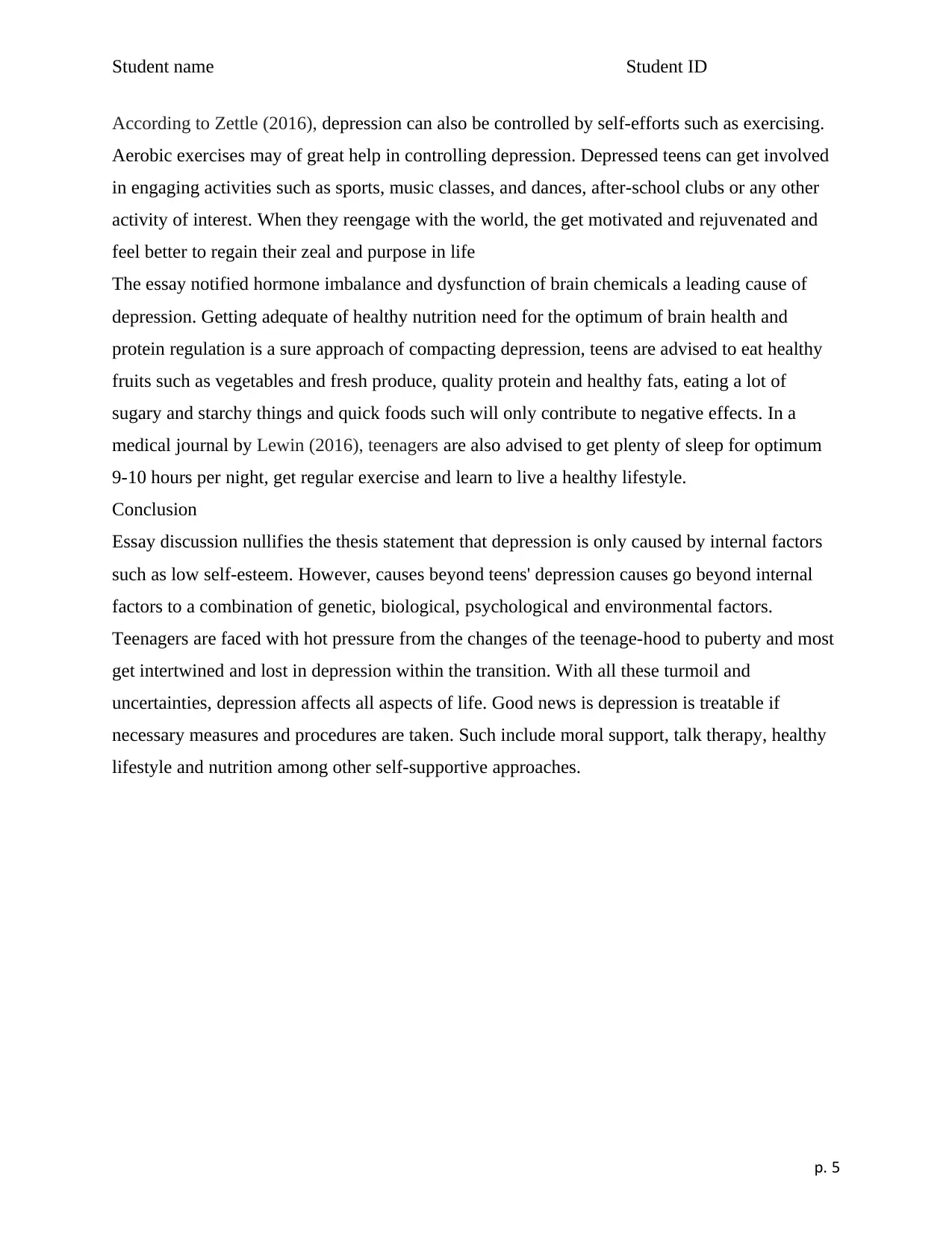
Student name Student ID
According to Zettle (2016), depression can also be controlled by self-efforts such as exercising.
Aerobic exercises may of great help in controlling depression. Depressed teens can get involved
in engaging activities such as sports, music classes, and dances, after-school clubs or any other
activity of interest. When they reengage with the world, the get motivated and rejuvenated and
feel better to regain their zeal and purpose in life
The essay notified hormone imbalance and dysfunction of brain chemicals a leading cause of
depression. Getting adequate of healthy nutrition need for the optimum of brain health and
protein regulation is a sure approach of compacting depression, teens are advised to eat healthy
fruits such as vegetables and fresh produce, quality protein and healthy fats, eating a lot of
sugary and starchy things and quick foods such will only contribute to negative effects. In a
medical journal by Lewin (2016), teenagers are also advised to get plenty of sleep for optimum
9-10 hours per night, get regular exercise and learn to live a healthy lifestyle.
Conclusion
Essay discussion nullifies the thesis statement that depression is only caused by internal factors
such as low self-esteem. However, causes beyond teens' depression causes go beyond internal
factors to a combination of genetic, biological, psychological and environmental factors.
Teenagers are faced with hot pressure from the changes of the teenage-hood to puberty and most
get intertwined and lost in depression within the transition. With all these turmoil and
uncertainties, depression affects all aspects of life. Good news is depression is treatable if
necessary measures and procedures are taken. Such include moral support, talk therapy, healthy
lifestyle and nutrition among other self-supportive approaches.
p. 5
According to Zettle (2016), depression can also be controlled by self-efforts such as exercising.
Aerobic exercises may of great help in controlling depression. Depressed teens can get involved
in engaging activities such as sports, music classes, and dances, after-school clubs or any other
activity of interest. When they reengage with the world, the get motivated and rejuvenated and
feel better to regain their zeal and purpose in life
The essay notified hormone imbalance and dysfunction of brain chemicals a leading cause of
depression. Getting adequate of healthy nutrition need for the optimum of brain health and
protein regulation is a sure approach of compacting depression, teens are advised to eat healthy
fruits such as vegetables and fresh produce, quality protein and healthy fats, eating a lot of
sugary and starchy things and quick foods such will only contribute to negative effects. In a
medical journal by Lewin (2016), teenagers are also advised to get plenty of sleep for optimum
9-10 hours per night, get regular exercise and learn to live a healthy lifestyle.
Conclusion
Essay discussion nullifies the thesis statement that depression is only caused by internal factors
such as low self-esteem. However, causes beyond teens' depression causes go beyond internal
factors to a combination of genetic, biological, psychological and environmental factors.
Teenagers are faced with hot pressure from the changes of the teenage-hood to puberty and most
get intertwined and lost in depression within the transition. With all these turmoil and
uncertainties, depression affects all aspects of life. Good news is depression is treatable if
necessary measures and procedures are taken. Such include moral support, talk therapy, healthy
lifestyle and nutrition among other self-supportive approaches.
p. 5
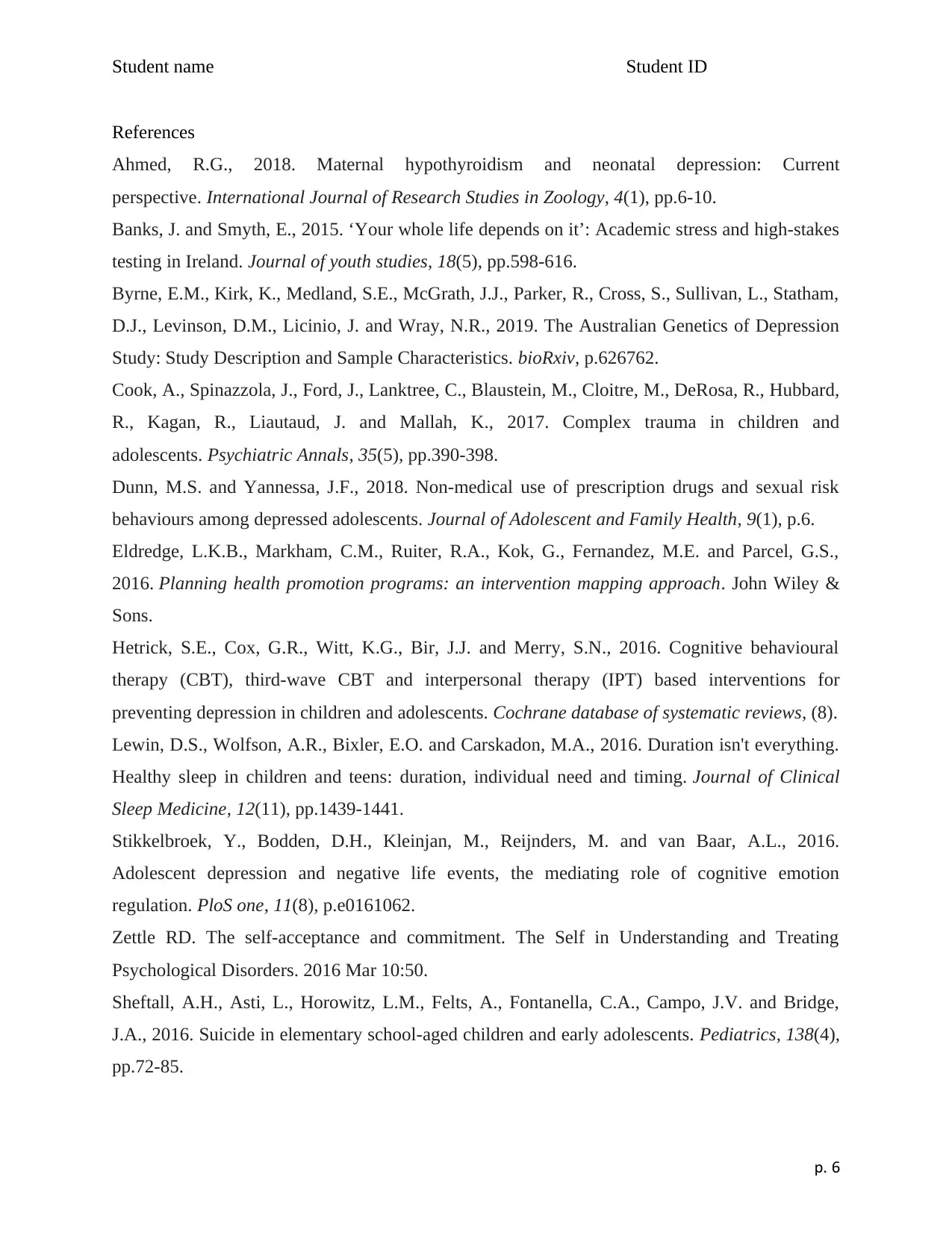
Student name Student ID
References
Ahmed, R.G., 2018. Maternal hypothyroidism and neonatal depression: Current
perspective. International Journal of Research Studies in Zoology, 4(1), pp.6-10.
Banks, J. and Smyth, E., 2015. ‘Your whole life depends on it’: Academic stress and high-stakes
testing in Ireland. Journal of youth studies, 18(5), pp.598-616.
Byrne, E.M., Kirk, K., Medland, S.E., McGrath, J.J., Parker, R., Cross, S., Sullivan, L., Statham,
D.J., Levinson, D.M., Licinio, J. and Wray, N.R., 2019. The Australian Genetics of Depression
Study: Study Description and Sample Characteristics. bioRxiv, p.626762.
Cook, A., Spinazzola, J., Ford, J., Lanktree, C., Blaustein, M., Cloitre, M., DeRosa, R., Hubbard,
R., Kagan, R., Liautaud, J. and Mallah, K., 2017. Complex trauma in children and
adolescents. Psychiatric Annals, 35(5), pp.390-398.
Dunn, M.S. and Yannessa, J.F., 2018. Non-medical use of prescription drugs and sexual risk
behaviours among depressed adolescents. Journal of Adolescent and Family Health, 9(1), p.6.
Eldredge, L.K.B., Markham, C.M., Ruiter, R.A., Kok, G., Fernandez, M.E. and Parcel, G.S.,
2016. Planning health promotion programs: an intervention mapping approach. John Wiley &
Sons.
Hetrick, S.E., Cox, G.R., Witt, K.G., Bir, J.J. and Merry, S.N., 2016. Cognitive behavioural
therapy (CBT), third‐wave CBT and interpersonal therapy (IPT) based interventions for
preventing depression in children and adolescents. Cochrane database of systematic reviews, (8).
Lewin, D.S., Wolfson, A.R., Bixler, E.O. and Carskadon, M.A., 2016. Duration isn't everything.
Healthy sleep in children and teens: duration, individual need and timing. Journal of Clinical
Sleep Medicine, 12(11), pp.1439-1441.
Stikkelbroek, Y., Bodden, D.H., Kleinjan, M., Reijnders, M. and van Baar, A.L., 2016.
Adolescent depression and negative life events, the mediating role of cognitive emotion
regulation. PloS one, 11(8), p.e0161062.
Zettle RD. The self-acceptance and commitment. The Self in Understanding and Treating
Psychological Disorders. 2016 Mar 10:50.
Sheftall, A.H., Asti, L., Horowitz, L.M., Felts, A., Fontanella, C.A., Campo, J.V. and Bridge,
J.A., 2016. Suicide in elementary school-aged children and early adolescents. Pediatrics, 138(4),
pp.72-85.
p. 6
References
Ahmed, R.G., 2018. Maternal hypothyroidism and neonatal depression: Current
perspective. International Journal of Research Studies in Zoology, 4(1), pp.6-10.
Banks, J. and Smyth, E., 2015. ‘Your whole life depends on it’: Academic stress and high-stakes
testing in Ireland. Journal of youth studies, 18(5), pp.598-616.
Byrne, E.M., Kirk, K., Medland, S.E., McGrath, J.J., Parker, R., Cross, S., Sullivan, L., Statham,
D.J., Levinson, D.M., Licinio, J. and Wray, N.R., 2019. The Australian Genetics of Depression
Study: Study Description and Sample Characteristics. bioRxiv, p.626762.
Cook, A., Spinazzola, J., Ford, J., Lanktree, C., Blaustein, M., Cloitre, M., DeRosa, R., Hubbard,
R., Kagan, R., Liautaud, J. and Mallah, K., 2017. Complex trauma in children and
adolescents. Psychiatric Annals, 35(5), pp.390-398.
Dunn, M.S. and Yannessa, J.F., 2018. Non-medical use of prescription drugs and sexual risk
behaviours among depressed adolescents. Journal of Adolescent and Family Health, 9(1), p.6.
Eldredge, L.K.B., Markham, C.M., Ruiter, R.A., Kok, G., Fernandez, M.E. and Parcel, G.S.,
2016. Planning health promotion programs: an intervention mapping approach. John Wiley &
Sons.
Hetrick, S.E., Cox, G.R., Witt, K.G., Bir, J.J. and Merry, S.N., 2016. Cognitive behavioural
therapy (CBT), third‐wave CBT and interpersonal therapy (IPT) based interventions for
preventing depression in children and adolescents. Cochrane database of systematic reviews, (8).
Lewin, D.S., Wolfson, A.R., Bixler, E.O. and Carskadon, M.A., 2016. Duration isn't everything.
Healthy sleep in children and teens: duration, individual need and timing. Journal of Clinical
Sleep Medicine, 12(11), pp.1439-1441.
Stikkelbroek, Y., Bodden, D.H., Kleinjan, M., Reijnders, M. and van Baar, A.L., 2016.
Adolescent depression and negative life events, the mediating role of cognitive emotion
regulation. PloS one, 11(8), p.e0161062.
Zettle RD. The self-acceptance and commitment. The Self in Understanding and Treating
Psychological Disorders. 2016 Mar 10:50.
Sheftall, A.H., Asti, L., Horowitz, L.M., Felts, A., Fontanella, C.A., Campo, J.V. and Bridge,
J.A., 2016. Suicide in elementary school-aged children and early adolescents. Pediatrics, 138(4),
pp.72-85.
p. 6
⊘ This is a preview!⊘
Do you want full access?
Subscribe today to unlock all pages.

Trusted by 1+ million students worldwide

Student name Student ID
Patel, V., Chisholm, D., Parikh, R., Charlson, F.J., Degenhardt, L., Dua, T., Ferrari, A.J., Hyman,
S., Laxminarayan, R., Levin, C. and Lund, C., 2016. Addressing the burden of mental,
neurological, and substance use disorders: key messages from Disease Control Priorities. The
Lancet, 387(10028), pp.1672-1685.
p. 7
Patel, V., Chisholm, D., Parikh, R., Charlson, F.J., Degenhardt, L., Dua, T., Ferrari, A.J., Hyman,
S., Laxminarayan, R., Levin, C. and Lund, C., 2016. Addressing the burden of mental,
neurological, and substance use disorders: key messages from Disease Control Priorities. The
Lancet, 387(10028), pp.1672-1685.
p. 7
1 out of 7
Related Documents
Your All-in-One AI-Powered Toolkit for Academic Success.
+13062052269
info@desklib.com
Available 24*7 on WhatsApp / Email
![[object Object]](/_next/static/media/star-bottom.7253800d.svg)
Unlock your academic potential
Copyright © 2020–2025 A2Z Services. All Rights Reserved. Developed and managed by ZUCOL.





